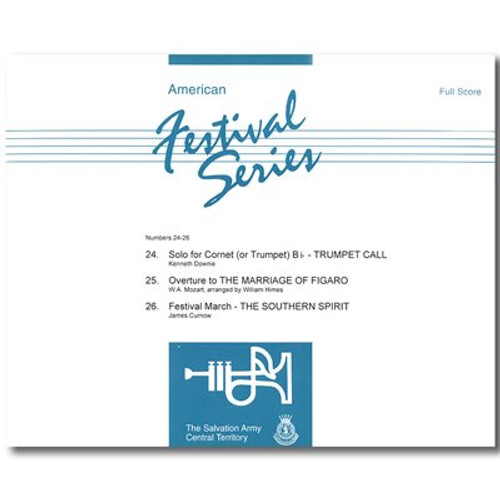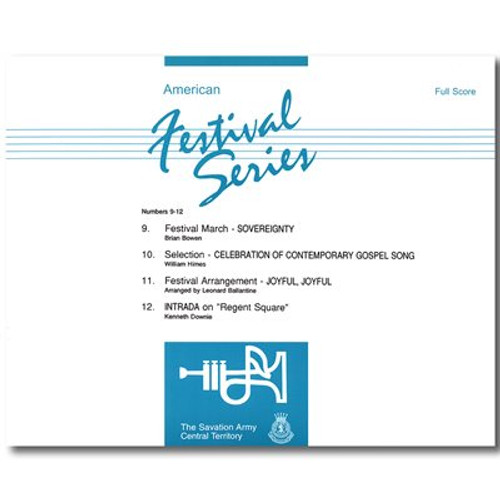Product Description
December 1995 Nos. 17-19
Comments by
Staff Bandmaster William Himes
Music Secretary, USA Central Territory
Score Sample |(sample music) |(view series guide)
17. Festival Arrangement - Joy in my Heart Ray Steadman-Allen Notes 18. Collage of Contemporary Praise William Himes Notes 19. Meditation - He Giveth More Grace James Curnow Notes
Produced by The Salvation Army - Central Territory17. Festival Arrangement - Joy in my Heart
Program Note:
This delightful collection of familiar choruses, written in the style of a Bavarian polka, include the following cheerful themes: "Joy, joy, my heart is full of joy," "Sing Hosanna," and "Oh, the blessed Lord."Note to the Conductor:
Apart from a deceptively calm introduction, this delightful concoction bubbles from start to finish in a toe-tapping polka style. Technical demands are minimal, making this piece quite accessible to most bands.
However, care must be taken to assure that volume does not take the place of energy. There can be a tendency to get caught up in the excitement and tempo of the music and overplay the dynamics. Strive for lightness throughout, reserving bursts of brilliance only in those passages marked f and ff.18. Collage of Contemporary Praise
Program Note:
This collection of songs and choruses is a tribute to the Praise and Worship movement, which in recent years has contributed music of unbounded joy and spiritual insight to revitalize the experience and focus on corporate worship. Melodies featured include "I've got the joy," "As the deer," "Ain't no rock," "Great is the Lord," "I love you, Lord" and "Awesome God".Note to the Conductor:
Grateful acknowledgement is expressed to the copyright holders of the six songs included in this selection for their kind permission to include their music in this selection.
This collection is a sequel to the previously published Celebration of Contemporary Gospel Song (AFS-10) which has enjoyed considerable use since its debut in 1990. As with its predecessor, Collage is written in much the same spirit as an overture to a Broadway musical with sharply contrasting idioms and a sweeping array of colors, textures and moods.
Intro: The key to this opening is irony: "Joy in the Salvation Army" should be presented in a mood of complacent predictability, so as to cause the listener to think "Is this contemporary? It sounds pretty traditional to me."
Bars 17-25: The idiom is rock and the style should be heavy- a jolting contrast from the aforementioned "Joy in the S.A." The answering quarter notes (crotchets) in beats 2 and 4 should be full and sustained. The success of the accelerando in bars 24-25 is totally dependent on the high hat cymbals found in Percussion I.
Bars 26-55: This section features Amy Grant's "I've got the joy". Take care to distiguish forte from fortissimo for the sake of musical interest as well as overall pacing and endurance.
Bars 56-61: Give full attention to the high-hat as this controls the rallentando and provides the transition into 62.
Bars 62-70: Don't take this section for granted. It appears quite easy, but because of its delicate transparency and constantly changing time signatures, this transition can have many pitfalls in terms of poise and accuracy.
Bars 71-103: Martin Nystrom's sumptuous song, "As the Deer," is warm with lyricism and emotion. Don't be afraid to be expressive, lingering on the slentandos when they occur. The main thing is to keep the melody to the fore while maintaining a restrained accompaniment.
Bars 104-180: A cut-time bar connects to the previous pause to provide the conductor with an opportunity to conduct two beats of the new (and quite quick) tempo before suddenly launching into this be-bop section. Two major objectives here will be to keep the tempo quick and steady.
For those unfamiliar with this popular youth song, the first verse referring to Palm Sunday- is as follows:Because the trombones are features, performance would be enhanced if the section stood to play at bars 112-143. The same is true for the cornet soloist at bars 147-168. The percussion section also provides an essential "kick" at bar 171.
- Ain't no rock gonna cry in my place,
- As long as I'm alive I'll glorify His holy name.
Bars 181-189: This sets the stage for a transition which is actually mathematical, whereby the long-established figure (as in the cornets and trombones at bar 182) becomes the waltz-like figure beginning in bar 188.
Bars 190-246: This setting of Michael W. Smith's "Great is the Lord" provides contrast- and even relief- from the boisterous section preceding it. Grazioso is the operative word: strive for lightness but with a good sense of waltz pulsation throughout.
Bars 247-254: Again, the transition at bar 247 is mathematical, with the pulse unchanged as the music crosses over from 6/8 to 4/4. The sound should be sonorous and majestic. Note the slight accelerando at bar 250 which has been included so that the tempo of the upcoming section does not languish for the euphonium soloist.
Bars 255-271: This setting of "I love you, Lord" should be played with utmost reverence, allowing the melody and accompaniment to virtually float with quiet intensity.
Bars 272-309: Judicious selection of tempo here will assure clarity and accuracy through this contrapuntal treatment of Rich Mullins' "Awesome God." As with all fugues, the entering subjects must be ready to "step aside" at the entry of succeeding subjects to assure clarity and continuity.
Dynamics should gradually escalate as the style is transformed from a refined, classical style to the hard rock idiom found at 298. At this point the style should be forceful and percussive through to bar 309.
Bars 310-317: This brief transition will present some technical challenge as a gradual accelerando is achieved in spite of a flurry of accidentals.
Bars 318-335: This reprise of "I love you, Lord" is presented with the "melodic core" (1-2 cornets, flugel, horns, baritones, euphonium) playing in a sonorous, majestic style while the other parts provide some percussive fireworks and fanfares. Give attention to preserving the f volume level until the entire band expands to ff at 326.
Bars 336-end: Make this finish quick and bright, with a swooping and dramatic crescendo coming from the timpani in the penultimate bar.19. Meditation- He Giveth More Grace
Program Note:
This expressive setting causes the listener to focus on the testimony of God's faithfulness found in Annie Johnson Flint's exquisite text:
- "His love has no limits,
- His grace has no measure,
- His power no boundary known unto men;
- For out of his infinite riches in Jesus
- He giveth, and giveth, and giveth again."
Note to the Conductor:
Although there are few technical demands, mature musicianship will be needed to project the beauty and intensity throughout this sensitive meditation.
Aside from a peak ff found at bars 53-54, the overall mood should be contemplative. It may seem trite to state, but a careful study of Annie Johnson Flint's immortal text will be very helpful in developing a meaningful interpretation.








